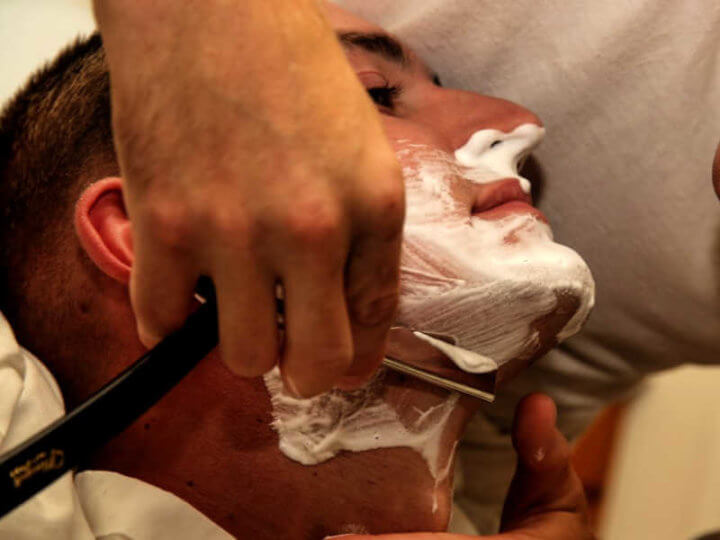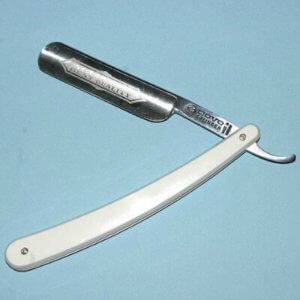
[Updated November, 2022.] Most men nowadays learn how to shave using a cartridge because they’re fast, convenient, cheap, and common. For those who are a bit more adventurous, a safety razor is a good option. They tend to give closer shaves than cartridge razors, not to mention less skin irritation. That’s why I always feel like a total bad boy when I whip out my straight razor for a shave – my roommates always say I’m crazy, but I say I like a good shave. So, that begs the question – are straight razors actually better than safety razors? Buckle up – I’m going to talk about the pros and cons of each, and by the end you’ll know which is best for you.
Safety Razors
First we’re going to talk about the more popular contestant, the safety razor.
Gillette popularized the safety razor circa 1901. The main feature of a safety razor is the safety guard that protects users from getting cut when shaving.
Design
Sometimes when you’re going through the motions as you have many times before, you’ll carelessly apply too much pressure.
This leads to skin irritation or worse, a cut. The obvious advantage of a safety razor is that it’s much harder (or so they say) to screw up like this thanks to its design.
Weight is a critical factor here – more massive razors glide more easily on your skin without you needing to apply much pressure at all.
Older men who might have shaky hands could benefit from the decreased risk of cutting themselves by using a safety razor as the device reduces the amount the edge can touch a user’s face, in addition to the angle.
The most popular safety razor design uses a double-edged blade, which allows the razor to cut with both sides. Although single-edged safety razors exist, double-edged blades tend to be cheaper.
While safety razors are a bit safer than other shaving devices that have exposed blades, you can still cut yourself if you’re not careful.

Head Design
Unlike cartridge razors which typically have a hinge connecting the blade to the handle, safety razors have a fixed metal handle with a blade attached firmly at the top. The blade will not move to sit flat on your face like a cartridge razor.
Instead, the user is required to angle the safety razor properly for a smooth shave. Otherwise, you may cut yourself or irritate your skin. It may take a bit to get the hang of it, but once you’ve got it down, it’s pretty easy.
You just have to keep the blade tilted at the right angle.
Due to safety razors’ fixed head, the person shaving needs to be patient, take things slow, and learn how to use the razor properly so they don’t risk cutting themselves.
Maintenance
Users can replace blades whenever the blade wears down, which is more convenient than having to sharpen a dull blade when using straight razors. Changes in skin due to skin conditions or different lengths of hair can also force a user to change shaving blades.
You’ll be prepared for these events with a safety razor, whereas, with a straight razor, you’ll have to keep working the same blade.
I recommend that users of a safety razor take apart their device every few months for a thorough cleaning. The average safety razor comes in three parts and is easy to take apart to clean through the use of boiling water.
Initial Investment
While a top-notch safety razor’s cost is comparable to the cartridge razor, the initial investment will produce a longer-lasting razor. Overall, the initial investment of purchasing a safety razor is less expensive than that of a straight razor.
Cheaper safety razors will have some plastic in the handle, while higher quality and more durable safety razors will have an all-metal handle. Safety razors are one of the least expensive ways to shave.
Safety razor double-edged blades can cost as low as around five cents per blade and last about a week with regular use. Typical disposable razors cost in the ballpark of forty cents per headpiece. $10 can typically get you one hundred blades.
When using a safety razor, you’ll be able to achieve a close shave that’s much safer than the close shave you get through a straight razor and with less practice.
Straight Razors

You know those things that look like swords your barber probably uses when you’re getting a haircut? And every time he pulls it out you pray that he won’t slice your throat open?
Okay, maybe that’s just me…
Either way, that’s probably why they’re sometimes referred to as cut-throat razors as well.
When used properly, straight razors give an insanely close shave. Additionally, straight razors are both durable and sturdy.
Unless you’re shaving enthusiast, making the switch to a straight razor may be a bit too much for you. However, they’re pretty awesome – just like every man needs a good watch, every man needs a good razor.
Using a straight razor requires skill and patience. Straight razors have a curved handle with an open blade that folds into the handle.
Before Gillette popularized the safety razor at the beginning of the 20th century, straight razors were the only option.
Professional barbers tend to use straight razors nowadays (when allowed by law), a whole lot more than the average person.
Part of the appeal that using a straight razor provides is the old-school, and authentic feel a user gets from the blade. There’s just something about being seconds away from death that you can’t beat.
Just kidding. Kind of.
Related Post: What Is The Best Straight Razor For Beginners? A Guide By Experts
Pre-Shave Routine
Users of straight razor blades have the option of sharpening used blades for longer-lasting equipment. A single, quality blade can last a lifetime.
However, more is required to shave with a straight razor as opposed to a safety razor.
Before shaving with a straight razor, I advise that users prep by applying a hot towel to their face, using a pre-shave oil, then putting on shaving cream before commencing.
Maintenance
You’ll need to re-sharpen the blade every few months on average. A typical straight razor blade is three inches long and will have a higher likelihood of cutting the user if dull.
Here are a couple of maintenance tools to look at buying when using a straight razor:
- Hones: help restore the blade’s teeth after repeated use
- Strops: serve to polish and straighten the straight razor blade
Following a straight razor shave, it’s crucial that users clean the blade with hot water, then dry the blade. The wash and dry method following a shave help prevent the blade from rusting. Olive oils and mineral oils can help maintain your blade as well.
Straight razors will cover more surface area with each stroke than a safety razor because their blades are much longer. Additionally, many straight razors allow you to swap your blade, meaning you can choose the blade that’s best for you.
Be Careful
Yeah, you’ll get a closer shave with a straight razor, but they can still be dangerous when misused. It takes practice to get accustomed to using a straight razor.
One mistake with a straight razor can lead to a bad neck or face injury. And yes, this is a bit dramatic and probably wouldn’t ever happen, but a straight razor could kill you. But so could any razor I suppose, so take this one with a grain of salt.
The main point is that it’s easier to make a mistake with a straight razor, as opposed to a safety razor (hence the name).
But here’s the deal:
As long as you’re careful, you’ll be fine.
When you start using a straight razor, rest your three middle fingers on the back of the blade, your thumb on the side of the blade, and your pinky on the blade’s handle (also known as a tang).
Don’t apply much pressure during the act of using a straight razor. Being gentle is key.
It’s a bit more difficult (and maybe scary) at first – but like all things, practice makes perfect. Unless you kill yourself. Just kidding.
While you’re going to spend some more money upfront to invest in a straight razor, you won’t have to worry about consistently buying replacement blades like you would with a safety razor. And you’ll look like a total bad boy in the process.
Both are Solid Options

Experienced shavers who understand how to use straight razors can choose more freely between the two options.
Like most things, everything boils down to personal preference.
While a disposable razor will produce the quickest and most efficient shave, making the switch to safety or straight razors will give you a higher quality shave that will reduce stubble the following day.
Disposable razors can have inconsistent results and irritate your skin. If your skin is easily irritated – that is, you find yourself getting razor burn (bumps) often, making the switch is a good idea.
In addition, following a proper pre-shave routine will lessen the likelihood of skin irritation after shaving with either type of blade.
Whatever your preference may be, both straight and safety razors will help you achieve a clean shave that exceeds the quality you’d get from using a disposable or cartridge razor.
Conclusion: Which Choice is Better Overall?
Style is a huge benefit of using a straight razor, as they exude a feeling of class and excellence that dates back centuries.
On the other hand, safety razors are recommended for the average person shaving, as staying safe is the primary concern with using a straight razor.
It’ll probably take a few months and quite a few shaves to become proficient with a straight razor, and it’s wise to be patient during this time.
While users of straight razors can re-sharpen blades without frequently purchasing new blades, it’s much more convenient to replace blades on a safety razor.
On the other hand, people who take pride in maintaining things will probably enjoy sharpening and cleaning their blades.
About the author
 My name is Tochi Duhu, and I am the owner of Swag Navigator. Over the years, I have developed a love for men’s fashion and lifestyle. I strongly believe every man should be confident in themselves – that means dressing your best, maintaining yourself, grooming properly, and dressing your best.
My name is Tochi Duhu, and I am the owner of Swag Navigator. Over the years, I have developed a love for men’s fashion and lifestyle. I strongly believe every man should be confident in themselves – that means dressing your best, maintaining yourself, grooming properly, and dressing your best.

I love my straights, they are collectables to me, I hone and strop and use them from time to time, but for me, nothing beats a feather blade,. I have very coarse beard hair and even feather blades are only good for one shave with me. Maybe I’m being picky but when I razor feels like it’s just wiping the hair off your face like it was never even attached is just awesome.
Nice article. I find that the real challenge with straight razors is honing them.
I have not found that a straight razor is closer than a safety razor, and several barber friends agree with me. The reason to chose a straight razor is aesthetic. It’s a traditional manly skill that requires considerable practice to master, and it makes you feel like a real badass. The downsides are that straights are very unforgiving of momentary lapses in technique and attention, and they require a lot of fussing with stropping and honing.
Before the invention of safety razors most men went to a barber for a shave, rather than shaving themselves. The fashion of of daily shaving became popular only after WWI. GIs had to be clean shaven to properly fit their gas masks, and were given Gillette safety razors as part of their kits. It was the invention of the safety razor that made self-shaving safe, quick, and popular.
By- the – way, I think that shavettes are not nearly as close or comfortable as Safety Razors or straights. They were invented for barbers who are banned by law in most states from using traditional straight razors.
I maintain that Safety Razors are as traditional as Straights, that they give a closer and more comfortable shave, and they are absolutely less dangerous. I have several friends who have tried straights and gone back to Safety Razors. They all trot out the straight from time to time and then put it back into repose.
In my book Safety Razors are still king!
Thanks for a great review article! As with all things about shaving, individual experiences vary. So I diverge from accepting the oft-stated assumption that straight razors give closer shaves than possible with a safety razor. I like my straight razors (cut throat and Rolls) but I don’t find they shave any closer than a properly wielded safety razor. I feel I have developed proper straight razor technique as I can shave routinely without nicks and get we I consider a BBS shave. However, I’ve also done repeated comparison shaves between my straights and safety razor and find My safety can out perform the straights. So I call it a draw 😉
Comments are closed.